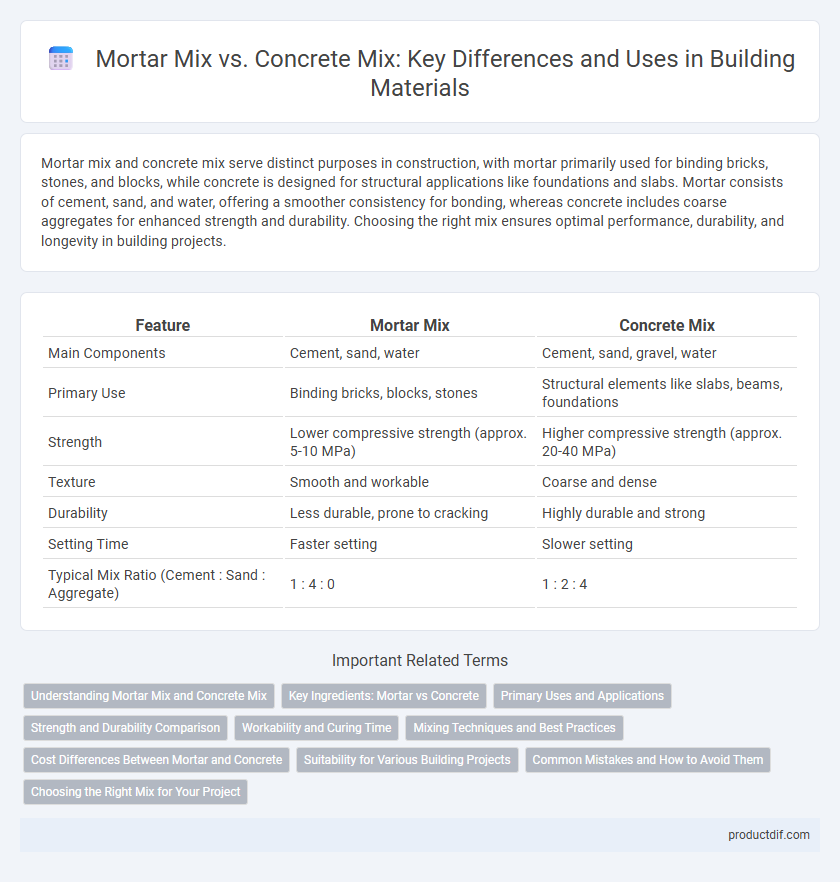Mortar mix and concrete mix serve distinct purposes in construction, with mortar primarily used for binding bricks, stones, and blocks, while concrete is designed for structural applications like foundations and slabs. Mortar consists of cement, sand, and water, offering a smoother consistency for bonding, whereas concrete includes coarse aggregates for enhanced strength and durability. Choosing the right mix ensures optimal performance, durability, and longevity in building projects.
Table of Comparison
| Feature | Mortar Mix | Concrete Mix |
|---|---|---|
| Main Components | Cement, sand, water | Cement, sand, gravel, water |
| Primary Use | Binding bricks, blocks, stones | Structural elements like slabs, beams, foundations |
| Strength | Lower compressive strength (approx. 5-10 MPa) | Higher compressive strength (approx. 20-40 MPa) |
| Texture | Smooth and workable | Coarse and dense |
| Durability | Less durable, prone to cracking | Highly durable and strong |
| Setting Time | Faster setting | Slower setting |
| Typical Mix Ratio (Cement : Sand : Aggregate) | 1 : 4 : 0 | 1 : 2 : 4 |
Understanding Mortar Mix and Concrete Mix
Mortar mix is a blend of cement, sand, and water designed primarily for binding bricks, stones, and blocks, providing adhesion and fill for masonry joints. Concrete mix consists of cement, sand, gravel or crushed stone, and water, formulated to create a strong structural material suitable for foundations, slabs, and load-bearing elements. Understanding the differences in composition and application ensures the correct mix is chosen for specific construction needs, optimizing durability and performance.
Key Ingredients: Mortar vs Concrete
Mortar mix primarily consists of cement, sand, and water, forming a workable paste ideal for binding bricks and stones, with a fine aggregate focus that enhances adhesion and flexibility. Concrete mix incorporates cement, sand, gravel or crushed stone (coarse aggregate), and water, creating a stronger and more durable composite suited for structural applications like foundations and slabs. The presence of coarse aggregate in concrete significantly increases its compressive strength, distinguishing it from the smoother, more pliable mortar mix.
Primary Uses and Applications
Mortar mix, composed primarily of cement, sand, and water, is designed for bonding bricks, stones, and blocks in masonry work, providing a strong yet flexible adhesive layer. Concrete mix includes cement, aggregates like gravel, sand, and water, formulated for structural applications such as foundations, slabs, and beams, offering superior compressive strength and durability. Mortar is ideal for vertical load-bearing elements and finishing joints, while concrete is essential for load-bearing structures requiring high strength and stability.
Strength and Durability Comparison
Mortar mix, composed primarily of cement, sand, and water, is designed for bonding bricks and stones, offering moderate strength and flexibility ideal for masonry joints. Concrete mix includes coarse aggregates and exhibits higher compressive strength and durability, making it suitable for structural elements like foundations and slabs. The denser composition of concrete mix provides superior resistance to weathering and load-bearing compared to mortar mix.
Workability and Curing Time
Mortar mix offers superior workability due to its finer sand content and higher water retention, making it ideal for bonding bricks and blocks with smooth application. Concrete mix, containing coarser aggregates, provides increased strength but requires more water for mixing, which can impact setting time and workability on-site. Mortar generally cures faster within 24 to 48 hours, while concrete demands longer curing periods of 7 to 28 days to achieve optimal structural integrity.
Mixing Techniques and Best Practices
Mortar mix requires a precise ratio of cement, sand, and water to achieve a smooth, workable consistency ideal for bonding bricks and blocks, typically mixed with a shovel or in a small mixer to prevent over-aeration. Concrete mix combines cement, sand, gravel, and water, demanding thorough mixing in a mechanical mixer to ensure uniform distribution and optimal strength for structural applications. Best practices include adding water gradually, mixing until a homogeneous texture is achieved, and avoiding excessive water to maintain durability and prevent shrinkage.
Cost Differences Between Mortar and Concrete
Mortar mix typically costs less than concrete mix due to its finer aggregates and smaller cement content, making it more economical for bonding bricks and stones. Concrete mix requires a higher proportion of cement, sand, gravel, and water, increasing its price because of its structural strength and durability. The cost difference can vary by region but generally ranges between 15% to 30%, with concrete being the more expensive option for construction projects.
Suitability for Various Building Projects
Mortar mix, composed of cement, sand, and water, is ideal for bonding bricks, stones, and blocks in masonry work due to its adhesive properties and smooth texture. Concrete mix, containing cement, sand, gravel, and water, offers superior compressive strength, making it suitable for structural applications like foundations, slabs, and load-bearing elements. Selecting between mortar and concrete depends on project requirements for strength, flexibility, and bonding capabilities in construction tasks.
Common Mistakes and How to Avoid Them
Common mistakes in mortar mix include using too much water, which weakens the bond and reduces durability, and failing to achieve the correct sand-to-cement ratio, leading to improper setting and cracking. In concrete mix, errors often involve improper aggregate sizing and inadequate mixing time, resulting in poor strength and uneven curing. To avoid these issues, follow precise measurement guidelines, maintain consistent mixing procedures, and conduct site-specific testing for optimal material performance.
Choosing the Right Mix for Your Project
Mortar mix consists of cement, sand, and water, designed for bonding bricks, stones, and blocks, providing strong adhesion but lower compressive strength than concrete mix. Concrete mix combines cement, sand, gravel, and water, offering higher durability and load-bearing capacity, ideal for structural foundations and slabs. Selecting the right mix depends on the project's requirements for strength, bonding, and finish, ensuring optimal performance and longevity.
Mortar Mix vs Concrete Mix Infographic

 productdif.com
productdif.com